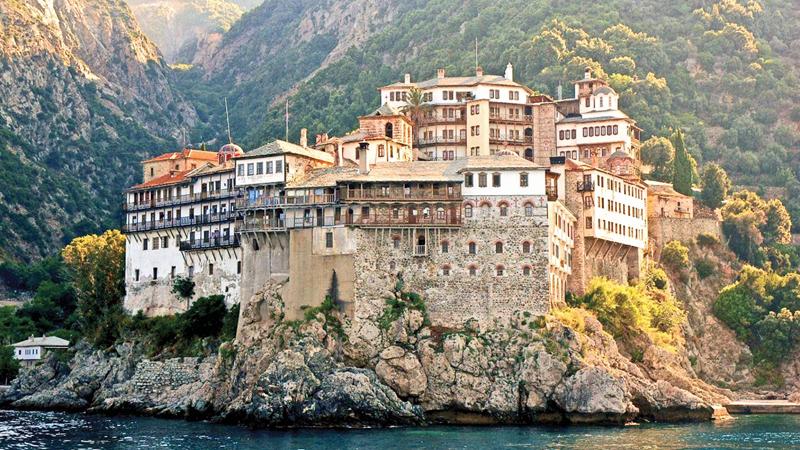
Laws based on religious considerations do not undergo changes as the other laws that change from time to time due to various economic, social and political reasons.
The main reason for this is that since religious beliefs are deeply rooted in any society, the rulers or the relevant institutions may be reluctant to change the rules based on such religious beliefs.
 The ban on a religious place in Greece is a case in point. For more than a thousand years, women have not been permitted to enter this complex, which is home to some of the orthodox Christian clergy. It is noteworthy that the ban remains unchanged even today. This article is about the ban and its history.
The ban on a religious place in Greece is a case in point. For more than a thousand years, women have not been permitted to enter this complex, which is home to some of the orthodox Christian clergy. It is noteworthy that the ban remains unchanged even today. This article is about the ban and its history.
Mount Athos
Mount Athos, an island in northwestern Greece, is a rocky outcrop. The religious place is located on one side of the hill. The premises are home to more than 2,000 Orthodox Christian clergy from around the world. The total number of places of worship on Athos Island is 20.
Situated on the top of Mount Athos, this premises has a history of over a thousand years. According to sources, the first Christian priests to migrate to this hilltop were in the first century AD.
Many of them are said to have fled as refugees from the then Roman Empire. During the Roman Empire, traditional clergymen were subjected to various forms of persecution, mainly influencing the migration of clergy to Mount Athos.
The number of clergy who migrated to Mount Athos increased greatly during the eighth and ninth centuries AD. The reason for this was that the Byzantine Empire at the time issued an edict banning all traditional Christian paintings and other religious writings.
Various persons
 In 885 CE, Basil I, Macedonian emperor, decided to provide protection for the clergy who lived on this hill. Accordingly, he took steps to prevent various persons from crossing the river around the summit of Mount Athos and entering this place illegally.
In 885 CE, Basil I, Macedonian emperor, decided to provide protection for the clergy who lived on this hill. Accordingly, he took steps to prevent various persons from crossing the river around the summit of Mount Athos and entering this place illegally.
He also designated the top of the hill as a sanctuary reserved for priests who came in the hope of becoming refugees. There was no Opposition from the Byzantine rulers to the presence of clergy without contact with the people who lived outside the island. The rulers also took steps to exempt the clergy who lived there from all taxes owed to the empire.
The first church (Great Lava) was built on Mount Athos in 963 AD. It was spearheaded by a Byzantine priest, St. Anthoinite, who founded the Anthoinite Orthodoxy, a Christian denomination.
Women are not allowed inside the premises or on the beach around it. They are allowed to come 500 metres close to the beach and see the church complex from a distance.
The ban on women coming to this place was imposed about a thousand years ago. Although there have been a number of social, economic, political and religious changes in Greece since then, nothing has been able to change or lift the ban.
First person
St. Anthoinite, who presided over the Athos church complex, set out a number of rules that the priests who lived there had to abide by throughout their lives. He is considered to be the first person to set out such a set of rules to be followed by the Orthodox Christian clergy.
This set of rules became legal in 970 CE when Emperor John I accepted the rules. A large plaque at the entrance to the temple complex displays the rules that must be followed not only by the priests who live on Mount Athos but also by anyone who climbs the mountain.
Even men who come to the top of the hill are allowed to enter only after a strict check. Orthodox Christian men are allowed to spend three nights here. Once a week, 100 people will have the opportunity to worship at the hilltop temples for three days.
